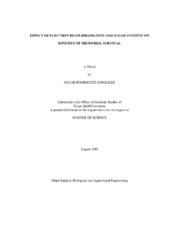| dc.contributor.advisor | Castell-Perez, Elena | |
| dc.creator | Rodriguez Gonzalez, Oscar | |
| dc.date.accessioned | 2006-10-30T23:28:28Z | |
| dc.date.available | 2006-10-30T23:28:28Z | |
| dc.date.created | 2005-08 | |
| dc.date.issued | 2006-10-30 | |
| dc.identifier.uri | https://hdl.handle.net/1969.1/4289 | |
| dc.description.abstract | The killing effectiveness of electron beam irradiation has not been completely
characterized. The type of microorganisms and the composition of food have a direct
effect on the efficiency of this technology. The objectives of this study were to select a
surrogate suitable for use in electron beam irradiation studies of fruits and to evaluate the
effect of sugar content on the kinetics of microbial damage and recovery. A 2.0 MeV Van
de Graaff linear accelerator was used to apply irradiation (up to 5.0 kGy), using different
configurations, on gelatin-based systems with the addition of sugars. The systems were
inoculated with pathogenic and non-pathogenic bacteria strains (surrogates). Initial
studies showed that Escherichia coli K-12 MG1655 is a suitable surrogate that represents
the damage induced to common fruit pathogens by irradiation. The reduction in bacteria
population can be maintained by storing samples at 4°C. An increase in temperature up to
20°C was enough for the damaged population to recover in 48 hours. Gelatin-based
systems proved to be a simple and inexpensive medium to evaluate the effects of
irradiation (up to 5.0 kGy) on selected bacteria. Reduction of the system dimensions and
their positioning related to the beam source were key factors in increasing the killing
effectiveness of irradiation. The sugar levels (up to 8 %) used to mimic the maturity of
cantaloupes had no effect on the radiation D10 values and the recovery of the surrogate population quantified as Generation Times. The resistance of the surrogate to irradiation
was validated in an optimum configuration and in cantaloupes. Temperature and sugar
content caused significantly higher changes to the physical structure of the gel-based
systems than irradiation (1.0 kGy). Plate counts and light microscopy techniques
demonstrated that the structure of the gelatin-based systems allow for motility of the
bacteria in a 3-D array (length, width and depth). When little information was available
about the effectiveness of using a low energy linear accelerator, the inoculation of
gelatin-based systems proved to be a reliable method to select a suitable surrogate and to
predict the effects of irradiation on bacteria as a function of sugar content. | en |
| dc.format.extent | 1356527 bytes | en |
| dc.format.medium | electronic | en |
| dc.format.mimetype | application/pdf | |
| dc.language.iso | en_US | |
| dc.publisher | Texas A&M University | |
| dc.subject | Microbes | en |
| dc.subject | Kinetics | en |
| dc.subject | Surrogates | en |
| dc.subject | Irradiation | en |
| dc.subject | Sugar | en |
| dc.subject | Food System | en |
| dc.title | Effect of electron beam irradiation and sugar content on kinetics of microbial survival | en |
| dc.type | Book | en |
| dc.type | Thesis | en |
| thesis.degree.department | Biological and Agricultural Engineering | en |
| thesis.degree.discipline | Biological and Agricutural Engineering | en |
| thesis.degree.grantor | Texas A&M University | en |
| thesis.degree.name | Master of Science | en |
| thesis.degree.level | Masters | en |
| dc.contributor.committeeMember | Castillo, Alejandro | |
| dc.contributor.committeeMember | Moreira, Rosana G. | |
| dc.type.genre | Electronic Thesis | en |
| dc.type.material | text | en |
| dc.format.digitalOrigin | born digital | en |


